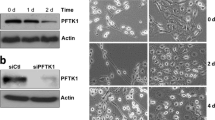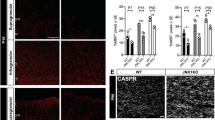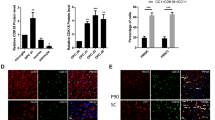Abstract
Oligodendrocytes are generated by the differentiation and maturation of oligodendrocyte precursor cells (OPCs). The failure of OPC differentiation is a major cause of demyelinating diseases; thus, identifying the molecular mechanisms that affect OPC differentiation is critical for understanding the myelination process and repairing after demyelination. Although prevailing evidence shows that OPC differentiation is a highly coordinated process controlled by multiple extrinsic and intrinsic factors, such as growth factors, axon signals, and transcription factors, the intracellular signaling in OPC differentiation is still unclear. Here, we showed that glycogen synthase kinase 3β (GSK3β) is an essential positive modulator of OPC differentiation. Both pharmacologic inhibition and knockdown of GSK3β remarkably suppressed OPC differentiation. Terminal deoxynucleotidyl transferase-mediated dUTP nick end-labeling assays and Ki67 staining showed that the effect of GSK3β on OPC differentiation was not via cell death. Conversely, activated GSK3β was sufficient to promote OPC differentiation. Our results also demonstrated that the transcription of myelin genes was regulated by GSK3β inhibition, accompanying accumulated nuclear β-catenin, and reduced the expression of transcriptional factors that are relevant to the expression of myelin genes. Taken together, our study identified GSK3β as a profound positive regulator of OPC differentiation, suggesting that GSK3β may contribute to the inefficient regeneration of oligodendrocytes and myelin repair after demyelination.







Similar content being viewed by others

References
Emery B (2010) Regulation of oligodendrocyte differentiation and myelination. Science 330:779–782
Huang H, Zhao XF, Zheng K et al (2013) Regulation of the timing of oligodendrocyte differentiation: mechanisms and perspectives. Neurosci Bull 29:155–164
Wolswijk G (2000) Oligodendrocyte survival, loss and birth in lesions of chronic-stage multiple sclerosis. Brain 123(Pt 1):105–115
Chang A, Nishiyama A, Peterson J et al (2000) NG2-positive oligodendrocyte progenitor cells in adult human brain and multiple sclerosis lesions. J Neurosci 20:6404–6412
Chang A, Tourtellotte WW, Rudick R et al (2002) Premyelinating oligodendrocytes in chronic lesions of multiple sclerosis. N Engl J Med 346:165–173
Billiards SS, Haynes RL, Folkerth RD et al (2008) Myelin abnormalities without oligodendrocyte loss in periventricular leukomalacia. Brain Pathol 18:153–163
Boespflug-Tanguy O, Labauge P, Fogli A et al (2008) Genes involved in leukodystrophies: a glance at glial functions. Curr Neurol Neurosci Rep 8:217–229
Segovia KN, McClure M, Moravec M et al (2008) Arrested oligodendrocyte lineage maturation in chronic perinatal white matter injury. Ann Neurol 63:520–530
Nave KA (2010) Myelination and support of axonal integrity by glia. Nature 2468:244–252
Taveggia C, Feltri ML, Wrabetz L (2010) Signals to promote myelin formation and repair. Nat Rev Neurol 6:276–287
Miller RH (2002) Regulation of oligodendrocyte development in the vertebrate CNS. Prog Neurobiol 67:451–467
Wang S, Sdrulla AD, diSibio G et al (1998) Notch receptor activation inhibits oligodendrocyte differentiation. Neuron 21:63–75
Charles P, Hernandez MP, Stankoff B et al (2000) Negative regulation of central nervous system myelination by polysialylated-neural cell adhesion molecule. Proc Natl Acad Sci U S A 97:7585–7590
Mi S, Miller RH, Lee X et al (2005) LINGO-1 negatively regulates myelination by oligodendrocytes. Nat Neurosci 8:745–751
Fu H, Qi Y, Tan M et al (2002) Dual origin of spinal oligodendrocyte progenitors and evidence for the cooperative role of Olig2 and Nkx2.2 in the control of oligodendrocyte differentiation. Development 129:681–693
Arnett HA, Fancy SP, Alberta JA et al (2004) bHLH transcription factor Olig1 is required to repair demyelinated lesions in the CNS. Science 306:2111–2115
Battiste J, Helms AW, Kim EJ et al (2007) Ascl1 defines sequentially generated lineage-restricted neuronal and oligodendrocyte precursor cells in the spinal cord. Development 134:285–293
He Y, Dupree J, Wang J et al (2007) The transcription factor Yin Yang 1 is essential for oligodendrocyte progenitor differentiation. Neuron 55:217–230
Liu Z, Hu X, Cai J et al (2007) Induction of oligodendrocyte differentiation by Olig2 and Sox10: evidence for reciprocal interactions and dosage-dependent mechanisms. Dev Biol 302:683–693
Wegner M (2008) A matter of identity: transcriptional control in oligodendrocytes. J Mol Neurosci 35:3–12
Fancy SP, Baranzini SE, Zhao C et al (2009) Dysregulation of the Wnt pathway inhibits timely myelination and remyelination in the mammalian CNS. Genes Dev 23:1571–1585
Emery B, Agalliu D, Cahoy JD et al (2009) Myelin gene regulatory factor is a critical transcriptional regulator required for CNS myelination. Cell 138:172–185
Cai J, Zhu Q, Zheng K et al (2010) Co-localization of Nkx6.2 and Nkx2.2 homeodomain proteins in differentiated myelinating oligodendrocytes. Glia 58:458–468
Ye F, Chen Y, Hoang T et al (2009) HDAC1 and HDAC2 regulate oligodendrocyte differentiation by disrupting the β-catenin–TCF interaction. Nat Neurosci 12:829–838
Grimes CA, Jope RS (2001) CREB DNA binding activity is inhibited by glycogen synthase kinase-3β and facilitated by lithium. J Neurochem 78:1219–1232
Chenn A, Walsh CA (2002) Regulation of cerebral cortical size by control of cell cycle exit in neural precursors. Science 297:365–369
Machold R, Hayashi S, Rutlin M et al (2003) Sonic hedgehog is required for progenitor cell maintenance in telencephalic stem cell niches. Neuron 39:937–950
Cohen P, Goedert M (2004) GSK3 inhibitors: development and therapeutic potential. Nat Rev Drug Discov 3:479–487
Frederick TJ, Min J, Altieri SC et al (2007) Synergistic induction of cyclin D1 in oligodendrocyte progenitor cells by IGF-I and FGF-2 requires differential stimulation of multiple signaling pathways. Glia 55:1011–1022
Iwata T, Hevner RF (2009) Fibroblast growth factor signaling in development of the cerebral cortex. Dev Growth Differ 51:299–323
Yoon K, Gaiano N (2005) Notch signaling in the mammalian central nervous system: insights from mouse mutants. Nat Neurosci 8:709–715
Kim WY, Wang X, Wu Y et al (2009) GSK-3 is a master regulator of neural progenitor homeostasis. Nat Neurosci 12:1390–1397
Corbin JG, Gaiano N, Juliano SL et al (2008) Regulation of neural progenitor cell development in the nervous system. J Neurochem 106:2272–2287
Hur EM, Zhou FQ (2010) GSK3 signaling in neural development. Nat Rev Neurosci 11:539–551
Ye P, Hu Q, Liu H et al (2010) Beta-catenin mediates insulin-like growth factor-I actions to promote cyclin D1 mRNA expression, cell proliferation and survival in oligodendroglial cultures. Glia 58:1031–1041
Aberle H, Bauer A, Stappert J et al (1997) Beta-catenin is a target for the ubiquitin-proteasome pathway. EMBO J 16:3797–3804
de Groot RP, Auwerx J, Bourouis M et al (1993) Negative regulation of Jun/AP-1: conserved function of glycogen synthase kinase 3 and the Drosophila kinase shaggy. Oncogene 8:841–847
Beals CR, Sheridan CM, Turck CW et al (1997) Nuclear export of NF-ATc enhanced by glycogen synthase kinase-3. Science 275:1930–1934
Neal JW, Clipstone NA (2001) Glycogen synthase kinase −3 inhibits the DNA binding activity of NFATc. J Biol Chem 276:3666–3673
Fuentealba LC, Eivers E, Ikeda A et al (2007) Integrating patterning signals: Wnt/GSK3 regulates the duration of the BMP/Smad1 signal. Cell 131:980–993
Ma YC, Song MR, Park JP et al (2008) Regulation of motor neuron specification by phosphorylation of neurogenin 2. Neuron 58:65–77
Takahashi M, Tomizawa K, Kato R et al (1994) Localization and developmental changes of tau protein kinase I/glycogen synthase kinase-3 beta in rat brain. J Neurochem 63:245–255
Coyle-Rink J, Del Valle L, Sweet T et al (2002) Developmental expression of Wnt signaling factors in mouse brain. Cancer Biol Ther 1:640–645
Yang Z, Watanabe M, Nishiyama A (2005) Optimization of oligodendrocyte progenitor cell culture method for enhanced survival. J Neurosci Methods 149:50–56
Hu JG, Fu SL, Wang YX et al (2008) Platelet-derived growth factor-AA mediates oligodendrocyte lineage differentiation through activation of extracellular signal-regulated kinase signaling pathway. Neuroscience 151:138–147
Li C, Xiao L, Liu X et al (2013) A functional role of NMDA receptor in regulating the differentiation of oligodendrocyte precursor cells and remyelination. Glia 61:732–749
Zhu J, Shao CY, Yang W et al (2012) Chronic zinc exposure decreases the surface expression of NR2A-containing NMDA receptors in cultured hippocampal neurons. PLoS ONE 7:e46012
Shao CY, Zhu J, Xie YJ et al (2013) Distinct functions of nuclear distribution proteins LIS1, Ndel1 and NudCL in regulating axonal mitochondrial transport. Traffic 14:785–797
Shaw M, Cohen P, Alessi DR (1997) Further evidence that the inhibition of glycogen synthase kinase-3beta by IGF-1 is mediated by PDK1/PKB-induced phosphorylation of Ser-9 and not by dephosphorylation of Tyr-216. FEBS Lett 416:307–311
Castano Z, Gordon-Weeks PR, Kypta RM (2010) The neuron-specific isoform of glycogen synthase kinase-3β is required for axon growth. J Neurochem 113:117–130
Ragot K, Delmas D, Athias A et al (2011) α-Tocopherol impairs 7-ketocholesterol-induced caspase-3-dependent apoptosis involving GSK-3 activation and Mcl-1 degradation on 158 N murine oligodendrocytes. Chem Phys Lipids 164:469–478
Bhat R, Xue Y, Berg S et al (2003) Structural insights and biological effects of glycogen synthase kinase 3-specific inhibitor AR-A014418. J Biol Chem 278:45937–45945
Lalor PA, Mapp PI, Hall PA et al (1987) Proliferative activity of cells in the synovium as demonstrated by a monoclonal antibody, Ki67. Rheumatol Int 7:183–186
Chen G, Bower KA, Ma C et al (2004) Glycogen synthase kinase 3β (GSK3β) mediates 6-hydroxydopamine-induced neuronal death. FASEB J 18:1162–1164
Azim K, Butt AM (2011) GSK3β negatively regulates oligodendrocyte differentiation and myelination in vivo. Glia 59:540–553
Jiang H, Guo W, Liang X et al (2005) Both the establishment and the maintenance of neuronal polarity require active mechanisms: critical roles of GSK-3β and its upstream regulators. Cell 120:123–135
Temple S, Raff MC (1986) Clonal analysis of oligodendrocyte development in culture: evidence for a developmental clock that counts cell divisions. Cell 44:773–779
Weng Q, Chen Y, Wang H et al (2012) Dual-mode modulation of Smad signaling by Smad-interacting protein Sip1 is required for myelination in the central nervous system. Neuron 73:713–728
Fu H, Cai J, Clevers H et al (2009) A genome-wide screen for spatially restricted expression patterns identifies transcription factors that regulate glial development. J Neurosci 29:11399–11408
Kondo T, Raff M (2004) Chromatin remodeling and histone modification in the conversion of oligodendrocyte precursors to neural stem cells. Genes Dev 18:2963–2972
Stolt CC, Schlierf A, Lommes P et al (2006) SoxD proteins influence multiple stages of oligodendrocyte development and modulate SoxE protein function. Dev Cell 11:697–709
Mukai F, Ishiguro K, Sano Y et al (2002) Alternative splicing isoform of tau protein kinase I/glycogen synthase kinase 3β. J Neurochem 81:1073–1083
Fancy SP, Harrington EP, Yuen TJ et al (2011) Axin2 as regulatory and therapeutic target in newborn brain injury and remyelination. Nat Neurosci 14:1009–1016
Behrens J, Jerchow BA, Würtele M et al (1988) Functional interaction of an axin homolog, conductin, with beta-catenin, APC, and GSK3beta. Science 280:596–599
Jho EH, Zhang T, Domon C et al (2002) Wnt/beta-catenin/Tcf signaling induces the transcription of Axin2, a negative regulator of the signaling pathway. Mol Cell Biol 22:1172–1183
Lustig B, Jerchow B, Sachs M et al (2002) Negative feedback loop of Wnt signaling through upregulation of conductin/axin2 in colorectal and liver tumors. Mol Cell Biol 22:1184–1193
Cross DA, Alessi DR, Cohen P et al (1995) Inhibition of glycogen synthase kinase-3 by insulin mediated by protein kinase B. Nature 378:785–789
Thornton TM, Pedraza-Alva G, Deng B et al (2008) Phosphorylation by p38 MAPK as an alternative pathway for GSK3β inactivation. Science 320:667–670
Acknowledgements
We thank Dr. Yi Rao (Beijing University, Beijing, China) for kindly providing the GSK3β-S9A plasmid. We are grateful for the helpful advice from the members of the Shen lab. We thank Dr. Iain C. Bruce for his help during the preparation of the manuscript. This work was supported by grants from the National Basic Research Program (973) of the Ministry of Science and Technology of China (2009CB941400, 2011CB504400, and 2013CB531300), the National Foundation of Natural Science of China (31260243, 31200818,31271148, 31060140, 31071879), the Zhejiang Provincial Foundation of Natural Science (LY12C09002), the Program for New Century Excellent Talents in University from the Ministry of Education of China for Ying Shen (NCET-07-0751) and Yin Wang, and the Fundament Research Funds for the Central University (2011FZA7002 and 2013QNA7007).
Conflict of Interest
All authors indicate that they do not have the financial relationship with the organizations that sponsored the current research.
Author information
Authors and Affiliations
Corresponding authors
Additional information
Liang Zhou and Chong-Yu Shao contributed equally to this work.
Electronic supplementary material
Below is the link to the electronic supplementary material.
Figure S1
Effects of AR-A on OPC differentiation are not mediated by T3. (A) Representative images of OLs stained with antibodies to MBP (red) and Olig2 (green) in the control (Ctrl) and AR-A groups. Cells were exposed to AR-A for 7 days without T3. Scale bar: 40 μm. (B) The percentages of MBP+ OLs in Olig2+ cells were 49 ± 3 % (Ctrl) and 23 ± 2 % (AR-A). (GIF 196 kb)
Rights and permissions
About this article
Cite this article
Zhou, L., Shao, CY., Xu, Sm. et al. GSK3β Promotes the Differentiation of Oligodendrocyte Precursor Cells via β-Catenin-Mediated Transcriptional Regulation. Mol Neurobiol 50, 507–519 (2014). https://doi.org/10.1007/s12035-014-8678-9
Received:
Accepted:
Published:
Issue Date:
DOI: https://doi.org/10.1007/s12035-014-8678-9



